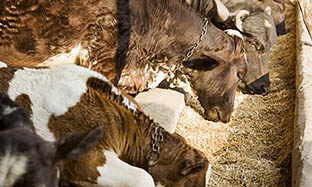
Cattle parasites: What are the peculiarities of external and internal parasites?
A parasite is an organism living on (ectoparasite) or in (endoparasite) another organism called host, at the expense of which it feeds. Parasitoses caused by these parasites are synonymous with loss of income for the farmer, because of the physiological disturbances they cause.
The main ectoparasites encountered in cattle are flies, lice, scabies, and ticks.
-
Flies: well known to breeders, only a thorough hygiene can limit invasions in summer.
-
Lice: we distinguish biting lice and grinding lice. Lice cause dermatitis, usually during the winter.
-
Scabies: it is due to mites. Psoroptic mange, sarcoptic mange and chorioptic mange are distinguished in cattle.
-
Ticks: they are vectors of serious diseases.
Grazing cattle are affected by 4 major parasites:
- The gastrointestinal strongyles (SGI), parasites of the abomasum, which cause significant growth losses or stunting in cattle. They are present in all cattle that have access to pasture. Infestation always begins with the ingestion spring grass with infesting larvae that have survived winter conditions. These then migrate to the target organs where they evolve into the adult stage. They lay eggs that are excreted in stool and contaminate the pasture.
- The respiratory strongyles. Dictyocaulus viviparus is a strongle that lives primarily in the airways of cattle. These worms, which are 3-8 cm long, cause significant damage to the lung tissue and obstruct the airways. The first symptoms observed are therefore respiratory disorders and coughing, hence the name "summer cough" given to this parasitosis, since it classically occurs when the animals are feeding on grass since 2 to 3 months, which is no longer true today with the appearance of cases all year round.
- The common liver fluke (Fasciola hepatica). It concerns cattle that have access to wetlands or humid areas because the parasite’s cycle involves a small aquatic snail, the Galba truncatula. The location of this parasite in the liver causes significant metabolic disturbances.
- The paramphistome. The paramphistomes, whose larvae are present, as in the case of the common liver fluke, in humid zones, are implanted on the wall of the rumen.
Whereas in the case of digestive strongyles, immunity is possible in adult animals, provided that the management of the first years of grazing is satisfactory, the animals do not immunize against the common fluke and paramphistomes, and little against respiratory strongyles.


